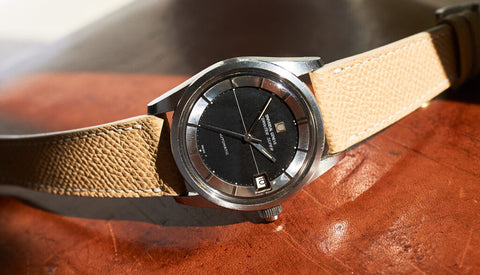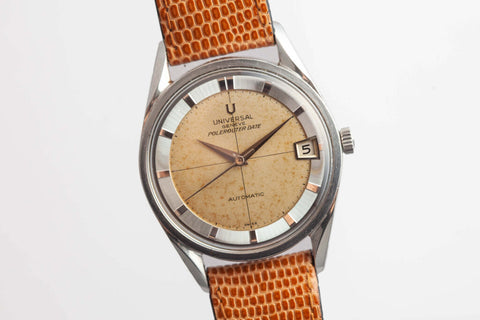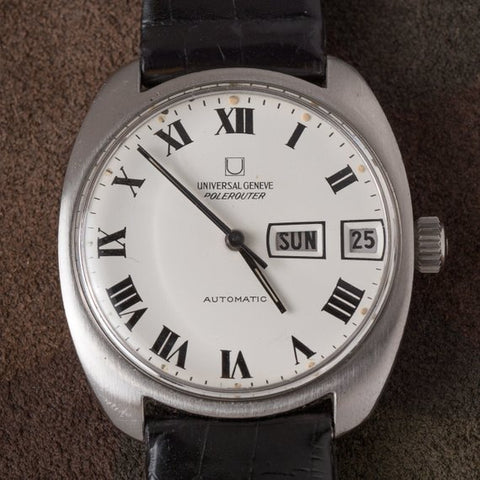The finest chronograph watches from Swiss luxury brand Universal Geneve
To watch the video, click here↓
I guess only vintage watch enthusiasts know about Universal Genève, right?
Universal Geneve is famous for its chronographs, but while many know how cool they are, not many people know about their history and appeal.
Did you know that Universal Genève watches have become popular again in recent years?
As the vintage boom spreads, collectors began to seek out affordable watches.
As a result, long-defunct brands like Universal Genève are experiencing a sort of renaissance, being rediscovered by a new generation of collectors.
This time, we will introduce the history of the rise and fall of Universal Geneva.
The article is divided into five parts
1. A very simple explanation of the history of Universal Geneva
2. The Birth of the Compact Series
3.What brand is the movement?
4. Universal Geneva and Nina Lint
5. Paul Rueter and Gerald Genta
6. Further Innovation: Micro-Rotor
7. Universal Geneva and the Present
It is as follows.
The beginning of Universal Geneva
Universal Genève was founded in 1894 in Le Locle, Switzerland by Georges Perret and Numa Emile Descombes .
At that time, the company name was " Descombes&Perret ", taken from the two men's names, and they sold watches under the brand name Universal Watch .
In 1919, the company moved its headquarters from Le Locle to Geneva, and in 1933 it changed its name to the Universal Watch Co Ltd. Geneve that we know today.
From the beginning, the company's advertising slogan was "Two watchmakers provide the cases, dials, movements and other components."
And as advertised, Universal produced most of its parts in-house.
Now, let's take a look at various chronographs that represent Universal Geneve.
The birth of the Compact series


In 1936, Universal Genève introduced their own chronograph, calling it the "Compax" .
The development of this chronograph was carried out with the cooperation of Martel Watch Co., a company that specializes in chronograph manufacturing.
I will talk more about Martell later in the article.
In addition to the Compact series, there are other models such as the following:
Uni-Compax

(Uni-Compax : A two- register chronograph with a 30-minute counter. )
In terms of its positioning, it may have been an introductory model, one level below the Compact.
Medico Compact (Medico Compact)

Medico-Compax : A chronograph wristwatch for medical professionals.
The dial says "pulsations," which means "pulse rate."
The outer edge of the dial is engraved with numbers that we don't usually see, so I guess they are numbers that only a doctor taking your pulse can understand.
Aerocompax

The most distinctive feature of this chronograph is that it appears to have two crowns.
The crown on the right is the crown that operates Memento, while the crown on the left is the crown that operates Memento.
"Memento" is a Latin word that means "to remember."
You can move the hands of this Memento by turning the crown on the left, but since it is not synchronized with the watch, the hands will not move automatically.

Aero-Compax
It is a chronograph with a 30-minute and 12-hour counter.
・30-minute counter at 3 o'clock
・Second hand at 9 o'clock
・12-hour counter at 6 o'clock
- Memento dial at 12 o'clock, operated by the crown at 9 o'clock
・Cal.281
By the way, this Memento dial display was patented by Universal Geneva.
As for how it is used, it would make sense if an alarm were to go off at a certain time, but that is not the case, so it is unclear how it is used.
The catalogue has a picture of someone who looks like an aviator drawn on it, so perhaps this function could be of some use to aviators.
Date Compact (Dato Compact)

Dato-Compax : A chronograph with a date display.
The function and layout are the same as the Aero Compax, with the date register at the 12 o'clock position.
Tricompax

The Tricompax is an amazingly complicated mechanical watch, and it is no exaggeration to say that it is the pinnacle of the Universal Genève series.
Due to its high quality and relatively reasonable price, this watch attracted many people after its release in 1944 and continued to be produced until 1960 .
The "Tri" in Tricompax (Tri=3) refers to the three calendars installed.
Not only is it a chronograph with a 30 -minute counter and a 12- hour counter, but it also has month, date, day of the week, and moon phase displays ( although the month must be changed manually ) .
When you consider that such a complex machine was mass-produced, you can see the incredible technological and manufacturing capabilities of Universal Genève.
At that time, it was difficult to develop, let alone manufacture, chronograph movements in-house.
Even another prestigious Swiss watch manufacturer, Patek Philippe, used improved movements from Valjoux.
In the midst of all this, Universal Genève continued to adhere to the philosophy set out by its founders: "Two watchmakers will provide the case, dial, movement and other components."
This is what is generally said about how amazing Universal Geneva is, but when it comes to the movement, it seems that there is a difference in perception between us Japanese and overseas.
What brand is the movement?
Up until now, I have consistently manufactured our own movements in-house.I've been talking about it this way, but as I looked into it further, the name "Martell" came up often.
Although we do not know whether this is true, it seems that Universal Geneva has been sourcing movements from Martel since 1918, and when Martel was later acquired by Zenith, a legendary chronograph manufacturer, Universal Geneva began using movements from another company.
In fact, the Nina Rindt models made in the 1960s and 1970s were equipped with Valjoux movements, and considering that Zenith acquired Martel in the 1960s, I think this story is more plausible.
However, despite having such advanced technical capabilities, it seems that Martel only supplied chronograph movements to Universal Geneve, so although I don't know the truth of the matter, I think it may have been some kind of subsidiary company established with investment from Universal Geneve, or that it may have had an exclusive contract.
That's why the movements of Zenith manual-winding chronographs from the 1960s and 1970s are almost the same as those made by Universal.
For example, the chronograph movement called "Martel Cal. 749" by Martel,
It is the Cal. 285 series of "Universal" and the Cal. 146 series of "ZENITH".

Universal is the oldest, so there are some slight differences, but as you can see, the basic design is almost the same.
Universal Geneva and Nina Lint
Perhaps the most popular Universal Geneva Compax at present is the "Nina Rindt" model.
The classic chronograph from the 1960s, the Nina Rindt, was made famous by Nina Rindt, wife of racing driver Jochen Rindt.

The ref 885103 is a panda-dial chronograph (a cream dial with black subdials) with a black tachymeter bezel, reminiscent of racing chronographs such as the Rolex Daytona.
The reverse panda dial was also called "Evil Nina" and attracted a lot of attention.
In reality, it's pretty hard to get both.

Paul Rueter and Gerald Genta
One of Universal Genève's signature three-hand watches is the Paul Router.
This watch was designed by jewelry designer Gerald Genta, who is not well known in Japan.

Although he was a famous watch designer, creating other masterpieces such as the Royal Oak for Audemars Piguet and the Nautilus for Patek Philippe, the Paul Router was his first brilliant design.
In 1954, Universal Genève commissioned Genta, who was 23 years old, to design a watch to celebrate the launch of Scandinavian Airlines' direct flights to Europe from New York and Los Angeles.
It was during this period that the first Rolex GMT-Master (Ref. 6542) was made for Pan Am pilots as they began their long-distance flights, marking the beginning of the era of aviation watches.

While this news made waves in aviation history, a new problem developed.
The problem is that the watch is exposed to strong magnetic fields.
Universal Genève was able to solve this problem because of its expertise in manufacturing antimagnetic watches, and Scandinavian Airlines chose Universal Genève as its official watch manufacturer.
Universal Genève then commissioned the creation of a new watch that would go down in aviation history.
This is how "Paul-Router," also pronounced Paul-a-Router, was born.
The first few hundred have the Scandinavian Airlines logo on them and are extremely rare.
Released in 1954, the watch features a 34.5mm case diameter and a uniquely textured dial.
Further Innovation: Micro-Rotor

Universal Geneva will continue to develop new products.
One of the most revolutionary features was the micro-rotor mechanism , patented in 1955 .
This mechanism was designed to slim down automatic movements, which tend to become larger as they become more functional.
The challenge was to remove the rotor, which is the cause of the thickness, from the center of the machine and make it smaller.
They then succeeded in achieving the complex and difficult task of embedding the miniaturized device inside the machine.
Before 1970 , there were only three companies making small rotor automatic mechanical watches: Universal, Buren, and Piaget.
Among them, Universal Geneve watches are most highly regarded for their beautiful design and construction when compared to other companies.
In 1955, the Polerouter was updated with Universal Geneve's new Cal. 215 micro-rotor movement and remained in production for 15 years.

https://italianwatchspotter.com/polaroid-polerouter-universal-geneve/?lang=en
Along with Hamilton, Universal Genève was one of the first companies to make mass-produced automatic movements possible, making watches affordable.
Since then, a variety of variations of the Polerouter have been released, including the Polerouter Sub, Polerouter Jet , Polerouter Deluxe, Polerouter Date, and Day Date, and watches with trapezoidal date windows have also become popular.

https://italianwatchspotter.com/polaroid-polerouter-universal-geneve/?lang=en

https://italianwatchspotter.com/polaroid-polerouter-universal-geneve/?lang=en

https://italianwatchspotter.com/polaroid-polerouter-universal-geneve/?lang=en
Golden Shadow & White Shadow

In 1965, the micro-rotor movement "Caliber 2-66" began production, leading to the birth of models such as the "Golden Shadow" and "White Shadow".

With a thickness of 2.3 mm, this movement was the thinnest automatic movement at the time.
Universal Geneva and the Present
Then, as the quartz crisis began to impact Universal Genève and the rest of the Swiss watch industry, the adoption of electric movements began.
Throughout the 1970s and 1980s, Universal Genève increasingly focused on quartz production, which resulted in the brand being devastated.
Paul Ruther's quartz models were not popular and were short-lived, and the brand's power, which had once been on par with that of Omega and Longines, had fallen to rock bottom by this time.
This blow resulted in the end of the corporate structure that had been inherited since the company's founding.
The full-scale renovation began in 2004.
That same year, Universal Genève released the limited edition Aero Tricompax as a tribute to the beloved classic.
Today, Universal Geneva remains owned by the Hong Kong investment group Stellax.
It is not easy to increase the value of a brand, and perhaps people choose brands such as Rolex, which are still popular today, because of the trust that can be found in their history.
Universal's history may have been lost, but as we have explained so far , the watches it made in its better days were a brand that boasted both stylish design and technical ability.
If you have the opportunity to encounter these watches, I believe you will be able to better understand their appeal by learning about their history and the knowledge and technical skill of the watchmakers who created them.
Famous people who loved Universal Geneva
Eric Clapton
During his time with Cream, Clapton was famously known for frequently wearing a Tricompax.
Jean Cocteau
The French poet Cocteau was one of the famous fans of Universal Genève, and he even included the names of Universal's limited edition models in his poems.
Also, although it is not a tricompax, the model Polerouter was adopted as the official watch for pilots of Scandinavian Airlines in the 1940s . It is named after the Arctic route between California and New York.



